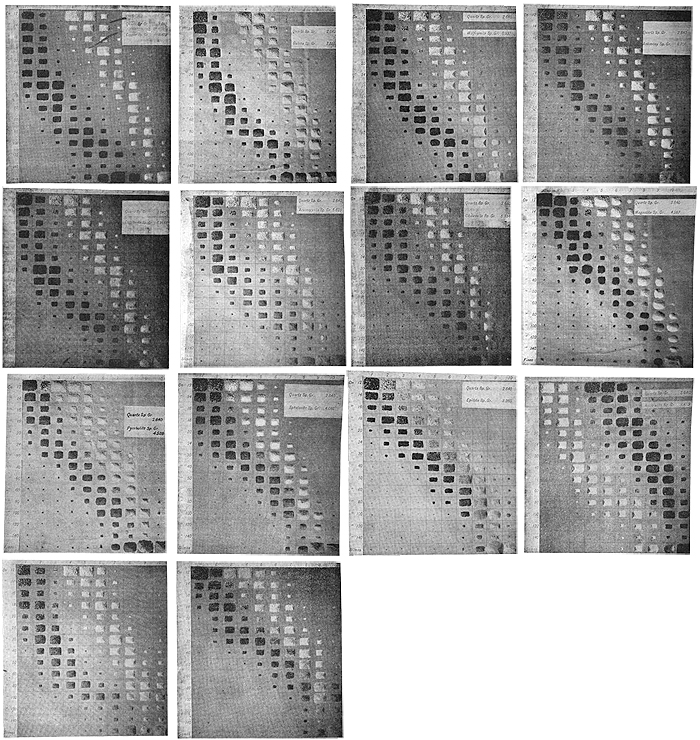and between the two, a valley almost destitute of grains

*
Figures 346-357, 361-662, illustrating “Tubular classified tests on hindered settling”
(cropped from their separate pages, and here rearranged),
in Chapter XV, Laws of Jigging, Robert Hallowell Richards. Ore Dressing. New York and London: The Engineering and Mining Journal, 1903.
Harvard copy, digitized October 15, 2007
—
“Hindered settling is affected by the same qualities of both minerals and liquids as free settling (see § 354). It adds, however, the effect of crowding grains together so thickly that the spaces between them are nearly as small as they would be in a closely sized product piled in a heap. Every particle in the mass is poised in the upward-moving water, settling issues with those above it, around it and below it. If a grain above it has greater settling power it quickly gets below, if one below it has less, it quickly rises.
“The effect of this upon mixed sizes of any one mineral, quartz, for example, will be to arrange them according to size; the largest grains will find their way to the bottom; the smallest will rise to the top. This order will only be interfered with by flat or elongated grains which will be a little higher in position than their size would seem to apply.
“The effect upon mixed sizes of two minerals of two specific gravities, for example, quartz and galena, will be to place grains in groups which may be said to be equal settling under hindered settling conditions, but the ratio between the diameters of the quartz and galena in any one of these groups is much greater than that obtained under free settling conditions. This ratio is of great importance, but there seems no way to get values for it except by direct test.
p 610
—
Each of these drawings, which were ten in number, was carefully dried, sized in the nest of sieves (see Table 258), and note made of the character of each size obtained. For example, the sizes in the galena series (see Fig. 347), in the fifth bulb, were found to be perfectly pure quartz down to the 30-mesh sieve. The 40-mesh contained a little galena; the 50-mesh was nearly all galena, with a little quartz; and all the sizes below 50-mesh were pure galena.
The twelve pairs of minerals were all treated in this way, and as a means of preserving the results, photographs were taken of the actual grains arranged in the form of a graphical plot. In these photographs (see Figs. 346-357), the vertical columns Nos. 1, 2, 3, 4, etc., represent the successive bulbs. The horizontal lines indicate groups of particals resting on like sieves.
p 612
tags:
classification; graphical plot; heaps; hindered settling; R. H. Richards. Ore Dressing (1903)